SSC Worksheet for chapter-2 Moving Objects class 9
Worksheet For class 9
Fill in the blanks
- _________ is the actual path followed by a body between the points it moves.
- _________ is the shortest distance between initial and final points of movement
- SI unit of speed or velocity is ________.
- The rate of change of velocity is called _________ .
- When there are equal changes in velocity of body in equal intervals of time, then it possesses ________ acceleration.
- Velocity, displacement and acceleration are __________ quantities while speed and distance are ________ quantities.
- For a body performing uniform circular motion its______ remains constant but velocity changes continuously.
- ________ or deceleration means negative acceleration.
- Direction of velocity of an object performing uniform circular motion is along _________ direction to its motion.
- Distinguish between
(b) Uniform motion and non-uniform motion
(c) Speed and velocity
- Derive the 3 equations of uniformly accelerated motion by graphical method
- Can velocity of a body change when speed remains constant? Give an example.
- Plot the pattern of distance-time graph for
(a) Uniform motion in straight line
(b) Uniformly accelerated motion
14. Plot the pattern of velocity –time graph for
(a) Uniform motion in a straight line
(b) Uniformly accelerated motion
15. A body moves along a straight line at a velocity of 10 m/s for 10 s and then at a velocity of 15 m/s for 15s. Find average velocity of the body
16. A particle moves on a circular track of length 600m in 120 seconds and returns to the starting point. Calculate the average speed and average velocity of the particle
17. A particle moves in a straight line with uniform acceleration. The initial velocity of the particle is 5 m/s and velocity after 10 s is 15 m/s, find
(a) Acceleration of particle
(b) Distance covered by particle in this time interval
18. The velocity of a car is reduced from 72 km/hr to 36 km/hr, while being uniformly retarded & covers a distance of 150 m during this time interval. Find magnitude of retardation of the car.
For other SSC Worksheet for class 9 Science check out main page of Physics Wallah.
Solutions
- Distance
- Displacement
- Metre/Second
- Acceleration
- Uniform
- Vector, scalar
- Speed
- Retardation
- Tangential
- (a)
| Distance |
Displacement |
|
(i)Distance is the total length of path traversed by the moving body irrespective of direction. (ii)It’s a scalar quantity |
(i)Displacement is the directed line segment between initial and final position of a moving body. (ii)It’s a vector quantity |
(b)
| uniform motion | non-uniform motion |
|
(i) A moving body that travels equal distances in equal time intervals is said to be in a state of uniform motion (ii) There should be no change in the velocity of the moving body which also means that there should be no acceleration and the body must have same speed over the distance covered |
(i)moving body that travels unequal distances in equal time intervals is said to be in a state of non uniform motion. (ii)the velocity of the moving objects changes several times and it also accelerates and decelerates |
(c)
| speed | velocity |
|
Speed is Distance travelled per unit time It’s a scalar quantity |
Velocity is Displacement per unit time It’s a vector quantity. |
11. Graphical Derivation of Equation of Motion:
(i) To Derive v = u + at By Graphical Methods
Let as consider a body moving with uniform acceleration ‘a’ having initial velocity ‘u’ attains the final velocity, in time ‘t’ covering a distance ‘s’ as shown in the graph
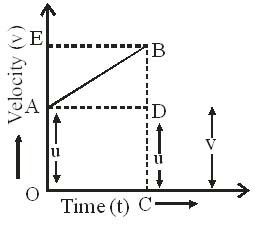
In the given velocity time graph,
Initial velocity, u = OA …(i)
Final velocity, v =BC …(ii)
From the graph,
= BC = BD + DC
= v = BD + OA(∵DC=OA)
= v = BD + u
To find the value of BD
Acceleration, a = slope of line AB
or a=BD/AD
= a=BD/t ∴(AD=OC=t)
= BD = at …(iv)
Putting BD =at in equation (iii)
(ii) To Derive= ut + 1/2 at2 By Graphical Method
Let us consider a body moving with uniform acceleration ‘a’ having initial velocity ‘u’ attains the final velocity ‘v’ in time ‘t’ covering a distance s as shown in the graph 8.1 (a).
Then from the graph:
Distance travelled by the body = Area under the velocity time graph
Distance travelled = Area of figure OABC = area of rectangle OADC + Area of triangle ABD
=S=(OA×OC)+(1/2 AD×BD)
=S=u×t+1/2 t×BD …(i)
To find the value of BD,
Acceleration, a = slope of line AB
Or a = BD/AD
= a = BD/ t ∴ (AD = OC = t)
=BD = at
Putting BD = at in equation (i) we get
s =ut + 1/2at2
(iii) TO Derive v2- u2 = 2asBy Graphical Method
Let us consider a body moving with uniform acceleration ‘a’ having initial velocity ‘u’ attains the final velocity ‘v’. In time‘t’ covering distance s as shown in the graph 8.1(a).
Then from the graph:
Distance travelled,‘s’ = area under the velocity time graph
i.e. Distance travelled, s = area of trapezium OABC
=(sumofparallelsides×hight)/2
s=((u+v)×t)/2 …(i)
To eliminate‘t’ from the above equation
We know, v = u =at
= v – u = at
= t = [( v - u)/a] …(ii)
By putting this value in equation (i),
We get,[( v + u)( v - u) /2a]
=v2= u2+ 2as
=v2- u2= 2as
12. Yes. Uniform circular motion
13. Velocity time graph
(a) Uniform motion in straight line
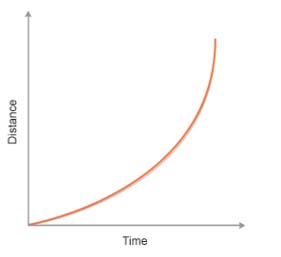
(b) Uniformly accelerated motion.
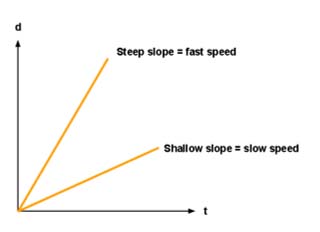
14.
(a)uniform motion in straight line
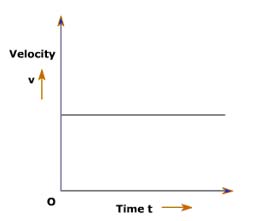
(b) Uniform accelerated motion
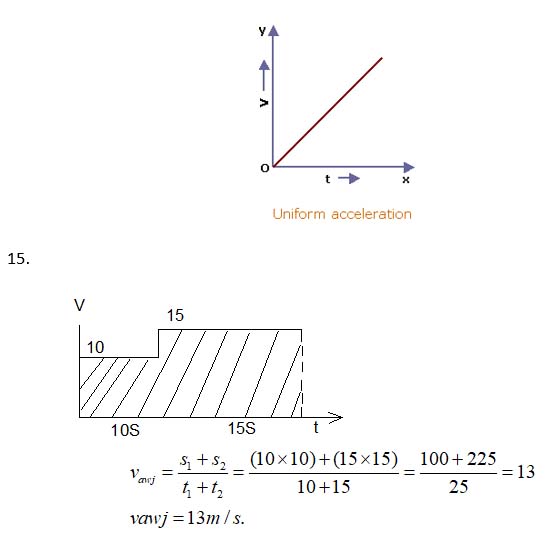
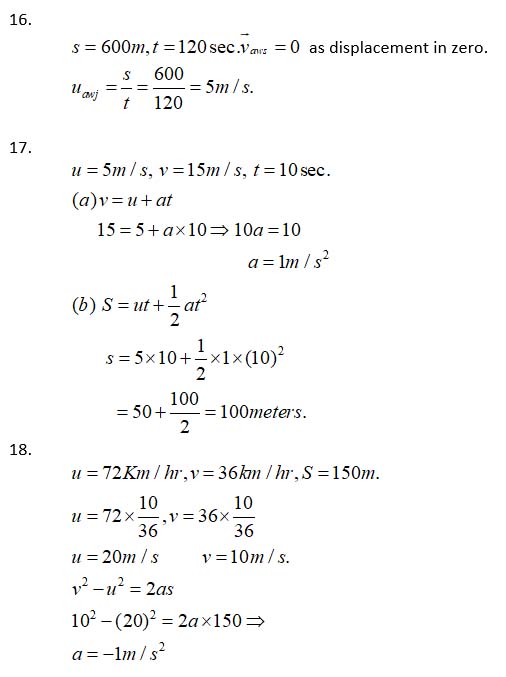
Related Link
- Class 9 Physics Notes
- Class 9 Chemistry Notes
- Class 9 Biology Notes
- Class 9 Maths Notes
- Class 9 Online Quiz Physics
- Class 9 Online Quiz Chemistry
- Class 9 Online Quiz Maths
- NCERT Solutions For Class 9
- RS Aggarwal Solutions Class-9
- RD Sharma solutions Class-9
- VK Agarwal Solution Class 9
- Lakhmir Singh Solutions Physics
- Lakhmir Singh Solutions Chemistry
- Important Question Class-9 Maths
- Important Question Class-9 Science
- Maths sample papers class 9
- Ask your Doubt
- Science Formulas
- Maths Formula
- NCERT Exemplar Class 9 Maths









